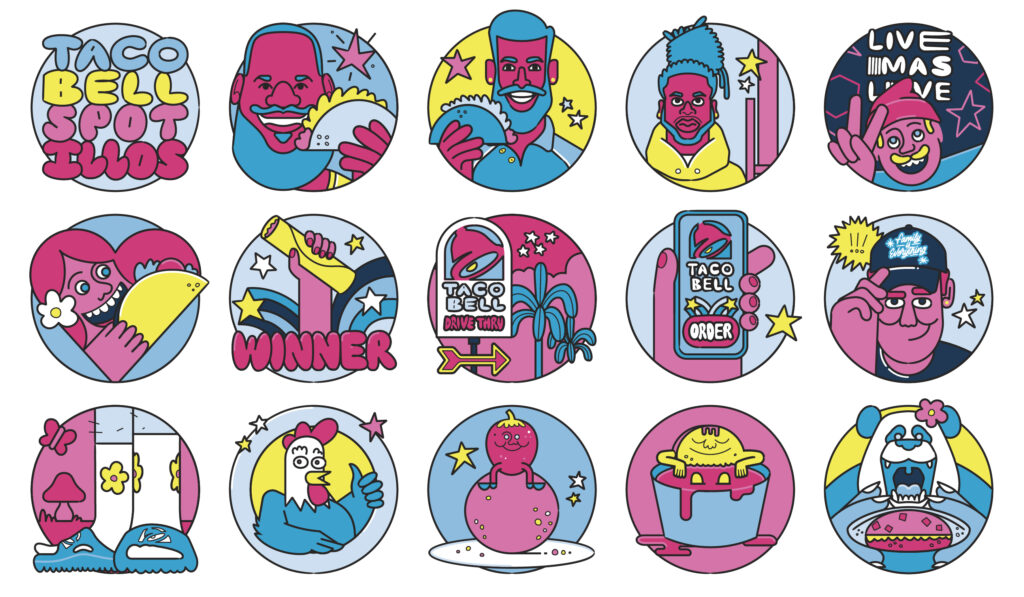From Psychedelia to Pop Art: Rick Hyde’s Vibrant Path to Illustration
An illustrator, animator, and designer based in Manchester, Rick Hyde channels his love of 1960s psychedelia, pop culture, and music into bold, character-driven work. His playful style–bursting with bright colours, bubble lettering and nostalgic flair–draws from comic books, cartoons, and contemporary illustration alike. Rick’s ongoing creative journey is fuelled by a constant search for the right frequency to spark his next idea.
Why did you decide to take up your creative trade?
I fell into it really. When I was doing my A-levels in the late 90s, I was into the rave scene in a big way. I spent most weekends travelling around the country with my mates, going to various club nights. We’d go to places like the Dielectric Club in Leicester, or Vibealite in Windsor Baths, Bradford.
Anyway, I found that raving and studying didn’t really mix well. Art was the only thing I could keep up with or stay interested in. I didn’t do very well in my other subjects, but came out with an A in art. So it was a simple choice, really. I then got a place on the Art Foundation at Stockport College, and took it from there.

How do you get past creative blocks?
It sounds really mundane, but doing something like folding laundry or washing the pots can help. I just stick my tunes on and do something routine where I don’t have to think too much.
If I’m stuck on a particular thing, sometimes it helps to think about it as I wake up. My half-asleep brain seems to be able to come up with solutions that my fully awake brain wouldn’t manage. I think there’s something about that transitional dream-like state that aids creativity.
If I’m on a tight deadline, then I take a break from the part of the project that’s causing me problems and focus on another bit. Usually, the thing I was struggling with seems easier when I come back to it.
What is your creative process?
It’s pretty simple, really. I start by sketching in Procreate. Once I’ve got a rough I’m happy with, I create a cleaner version which I send to the client. If revisions are required, I repeat this stage until the drawing is signed off. Next, I create a number of colour roughs to share. Then, when I have a palette approved, I create the final artwork in Adobe Illustrator.
That’s my basic approach anyway. There’s a bit more involved if I’m working on an animation, or a 3D piece in Womp, but the starting point is usually the same.

Where do you look for inspiration?
I think you’re always looking for inspiration on some level, as a creative person, consciously or unconsciously. Sometimes an idea just comes to you when you’re walking to the shops or making a brew, for example. It can be something you overhear in conversation, or anything.
I’m always listening to music, so that’s a reliable source. Whether it’s the melody, a lyric, or just a general vibe, music can transport you to a different place or time. It’s a cliché, I know, but it’s true. Beyond that, it’s the common tropes, I guess. Film, literature, other visual art, etc.
What are you reading or listening to right now?
I’m attempting to read The Nickel Boys by Colson Whitehead. It was on my radar because it’s recently been adapted to film. I say attempting because I read in bed, and rarely get through a couple of pages before nodding off.
An album I’ve been revisiting a lot recently is Spirit Of The Golden Juice by F.J. McMahon. It’s a real gem of a record, and a must for fans of great songwriting and poetic storytelling.

What has been your favourite project to date and why?
Last year, I was asked to create a series of spot illustrations for an article on Taco Bell. The piece was featured in the March/April 2024 issue of Fast Company magazine and discusses Taco Bell’s strategy for global cultural domination, under the leadership of new CEO Sean Tresvant. I got to draw sporting icons like LeBron James and Hardik Pandya eating Tacos. I mean, what’s not to love?
A big thank you to Rick Hyde for contributing to our series of creative conversations with industry experts.